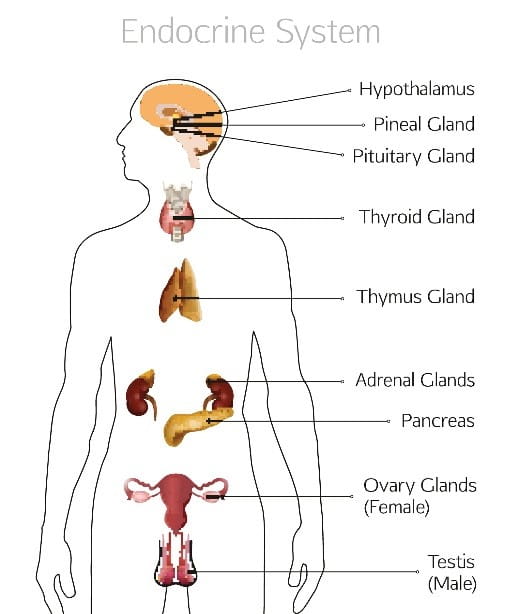What is the Anatomy of the Endocrine System?

- Growth
- Reproduction
- Sexual development
- Energy
- Response to physical stress or trauma
- Levels of water, salt and sugar in the body
Hypothalamus
The hypothalamus is located in the center of the brain. It makes hormones that increase or decrease the release of the hormones made in the pituitary gland. It also makes hormones that help to control water balance, sleep, temperature, appetite and blood pressure.
Pituitary
The pituitary gland is located at the base of the brain and is about the size of a pea. It is the master gland in the endocrine system. It regulates the amounts of hormone made by the thyroid gland, adrenal gland, and testes or ovaries. It also makes the hormones prolactin, vasopressin and growth hormone.
Thyroid and Parathyroid
The thyroid gland and parathyroid glands are located in front of the neck, below the larynx (voice box). The thyroid plays an important role in the body's growth and development, as well as weight and energy. The thyroid and parathyroid glands play a role in controlling the level of calcium in the body.
Adrenal Gland
The adrenal glands are located on top of each kidney. The adrenal glands make hormones that help the body deal with stress and illness. The hormones made by the adrenal gland also maintain blood pressure and blood glucose, and play a role in sexual development.
Pancreas
The pancreas is located behind the stomach. It plays a role in digesting food, but it also makes hormones. The pancreas makes insulin, which is important for blood glucose control.
Ovaries
A female's ovaries are located on both sides of the uterus, below the opening of the fallopian tubes (which extend from the uterus to the ovaries). The ovaries contain the egg cells necessary for reproduction and also produce the hormones estrogen and progesterone. These hormones regulate the menstrual cycle.
Testes
A male's testes are located in the scrotum. The testes produce testosterone and sperm. The testes produce the hormone testosterone, which is responsible for the development of male characteristics, and protects muscle and bone health.



